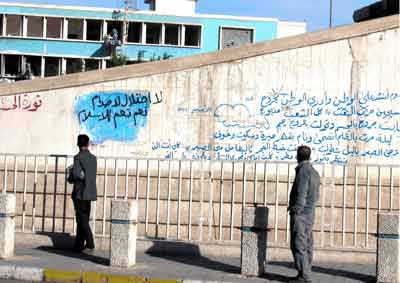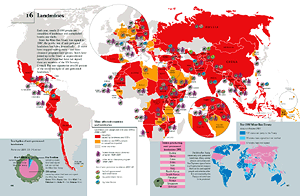war
The World Still Says No to War
 Those little blue stickers are popping on the streets of New York again. This Saturday, on the one-year anniversary of the invasion of Iraq, millions will take to the streets to call for peace. Protests are scheduled in over 50 countries, with over 200 events planned around the United States.
Those little blue stickers are popping on the streets of New York again. This Saturday, on the one-year anniversary of the invasion of Iraq, millions will take to the streets to call for peace. Protests are scheduled in over 50 countries, with over 200 events planned around the United States.
United for Peace and Justice has made variations on their “flag” flyer template available for download with space to add details about your local event or create your own translation, and with rotated globes for events in Africa, Asia, or Europe.
By now there are plenty of downloadable flyers on the Web, but few designed for translation and personalization, while retaining a generally persistent brand. I’ve not seen another organization producing anti-war posters this user-oriented.
Except the Bush-Cheney presidential campaign.
From Wired:
“The Bush-Cheney presidential campaign disabled features of a tool on its website Thursday that pranksters were using to mock the Republican presidential ticket.
The tool originally let users generate a full-size campaign poster in PDF format, customized with a short slogan of their choice. But Bush critics began using the site to place their own snarky political messages above a Bush-Cheney ’04 logo and a disclaimer stating that the poster was paid for by Bush-Cheney ’04, Inc.”
See a handful of sample posters in this nostalgic Fash piece.
Mapping Feedback
 As far as centrally-coordinated online campaigns go, one technique I’ve particularly admired about MoveOn’s organizing is the way the coordinators gather feedback and circulate it back to the participants of a given action. Participants around the world can read about of what others are doing, and get a sense of the impact and scale of the action. Too many organizations simply fail to ask who is taking offline action. And many send out endless streams of urgent action alerts with little, if any, follow-up.
As far as centrally-coordinated online campaigns go, one technique I’ve particularly admired about MoveOn’s organizing is the way the coordinators gather feedback and circulate it back to the participants of a given action. Participants around the world can read about of what others are doing, and get a sense of the impact and scale of the action. Too many organizations simply fail to ask who is taking offline action. And many send out endless streams of urgent action alerts with little, if any, follow-up.
Usually MoveOn’s updates arrive as the text of an email, but this Flash driven map does the job visually and interactively. The map effectively presents both the macro and micro views of the many house parties organized across the U.S. on December 7, 2003 to view the documentary Uncovered: The Whole Truth about the Iraq War.
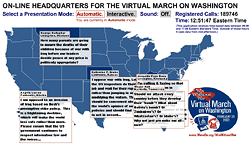 Despite the initial written instructions, the interface could be made a little more intuitive by giving shapes of the states some kind of rollover behavior.
Despite the initial written instructions, the interface could be made a little more intuitive by giving shapes of the states some kind of rollover behavior.
Still, I find it more informative than MoveOn’s previous action map. This map of the February 26, 2003 phone-in rotates the display of only one tesimony per state. Instead of plotting data the map paints a more atmospheric picture of the plurality of voices and the outrage that rained upon the Capitol that day. The geographic shapes only provide a general spatial context to the ticking clock and growing tally of calls.
Between the two is a world map of candle light vigils organized on March 16, 2003. The map displays testimonies, photos, and the sites of vigils, but the user is unable to draw any actual numbers from it, only impressions. The zoom effect is gorgeous, but the testimonies quickly overwhelm, like hundreds of little pop-up windows you’re unable to move or close.
The maps were all designed and programmed by Stamen Design in San Francisco.
...
See also this Jully 2004 item about Stamen Design’s live, interactive conference call map.
Whose Streets?
Drapetomaniac sends a link to this video clip of an interview with Casey Blake. Professor Blake is
“currently working on three book-length projects: Public Art and the Civic Imagination in Contemporary America... an edited volume titled The Arts of Democracy: Art, Civic Culture, and The State... and a collection of essays on the culture and politics of the 1970s.”
I’ve transcribed the clip below.
“In the early and mid-1960’s, the Federal Government initiated two significant programs for funding public art in the United States, and these programs in effect became the leaders in the public art field in this country during the 60’s and 70’s and in some ways beyond.
The first of these was the Art and Architecture Program of the General Services Administration which sponsors public art installations inside and outside federal office buildings and courthouses. And, the second is the Art in Public Places Program of the National Endowment for the Arts which was founded in 1965.
Both of these programs were very much the creation of liberals in the Kennedy administration and after that in the Johnson administration, and also within the Rockefeller wing of the Republican party. And, I think that the architects of these programs were all men who were steeped in European culture. They were knowledgeable about the history of European art and European Modernism in particular, and they wanted to see the United States — now a military and economic power — come of age as a kind of artistic power in the world and produce artwork that could bear comparison to the great works of high European Modernism.
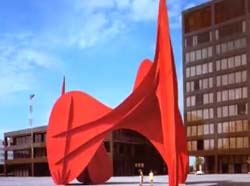 These were also anti-Communists and they believed that federally sponsored public art programs, and arts programs generally, could play a role in furthering the mission of the United States in its global campaign against the Soviet bloc, in large part by holding up the artistic achievements of the United States as an example of what a civilization devoted to individual freedom was capable of producing, and then, finally, a program that attempted to remake American cities along modernist lines.
These were also anti-Communists and they believed that federally sponsored public art programs, and arts programs generally, could play a role in furthering the mission of the United States in its global campaign against the Soviet bloc, in large part by holding up the artistic achievements of the United States as an example of what a civilization devoted to individual freedom was capable of producing, and then, finally, a program that attempted to remake American cities along modernist lines.
I think that when you look at the federal programs that sponsored public art installations in the United States beginning in the mid-1960’s, and then developing further in the late 60’s and early 70’s, you see that these programs were all inspired by a set of assumptions and by a notion of cultural authority that came under attack almost immediately after these programs were put into place. In particular, the notion that artistic decisions and decisions about the uses and design of public spaces should be best left to experts, in particular experts in the visual arts, came under attack almost immediately first from the political left, in many cases from the political right, but I think more broadly from a kind of popular revolt at the local level. I think that on the whole, those people who were angry about public art in this period, in the 70’s and 80’s were asking a vitally important question, namely, ‘What was “public” about them? Who was the public that was going to decide what public art was going to appear in public spaces?’
I think that beyond the question of ‘who decides what art should appear in public spaces?’ and ‘what makes it public?’, the protests of the 1970’s had to do with questions about the fate of the American city in this period. In the 1960’s public art was very explicitly linked to a program of urban renewal that promised a kind of modernist revitalization and redesign of American cities. By the mid-1970’s with the fiscal crisis of American cities setting in in earnest, I think it became very difficult to believe that public art on its own could somehow remake urban culture. More to the point that you see beginning in the 70’s and certainly continuing through the 80’s, a kind of backlash against the idea of urban renewal that had been promulgated after World War II that relied so heavily on the bulldozing of traditional neighborhoods and their replacement by modernist forms of planning and architecture. So in many ways, by the mid-to-late 1970’s public art installations no longer seem like these vehicles of urban revitalization, but rather seem like the most visible symbols of a liberal urban project that had gone terribly wrong.”
Orientation
From Beyond Vietnam: A Time to Break Silence:
“In 1957 a sensitive American official overseas said that it seemed to him that our nation was on the wrong side of a world revolution. During the past ten years we have seen emerge a pattern of suppression which now has justified the presence of U.S. military ‘advisors’ in Venezuela. This need to maintain social stability for our investments accounts for the counter-revolutionary action of American forces in Guatemala. It tells why American helicopters are being used against guerrillas in Colombia and why American napalm and green beret forces have already been active against rebels in Peru. It is with such activity in mind that the words of the late John F. Kennedy come back to haunt us. Five years ago he said, ‘Those who make peaceful revolution impossible will make violent revolution inevitable.’
Increasingly, by choice or by accident, this is the role our nation has taken — the role of those who make peaceful revolution impossible by refusing to give up the privileges and the pleasures that come from the immense profits of overseas investment.
I am convinced that if we are to get on the right side of the world revolution, we as a nation must undergo a radical revolution of values. We must rapidly begin the shift from a ‘thing-oriented’ society to a ‘person-oriented’ society. When machines and computers, profit motives and property rights are considered more important than people, the giant triplets of racism, materialism, and militarism are incapable of being conquered.
A true revolution of values will soon cause us to question the fairness and justice of many of our past and present policies. On the one hand we are called to play the good Samaritan on life’s roadside; but that will be only an initial act. One day we must come to see that the whole Jericho road must be transformed so that men and women will not be constantly beaten and robbed as they make their journey on life’s highway. True compassion is more than flinging a coin to a beggar; it is not haphazard and superficial. It comes to see that an edifice which produces beggars needs restructuring. A true revolution of values will soon look uneasily on the glaring contrast of poverty and wealth. With righteous indignation, it will look across the seas and see individual capitalists of the West investing huge sums of money in Asia, Africa and South America, only to take the profits out with no concern for the social betterment of the countries, and say: ‘This is not just.’ It will look at our alliance with the landed gentry of Latin America and say: ‘This is not just.’ The Western arrogance of feeling that it has everything to teach others and nothing to learn from them is not just. A true revolution of values will lay hands on the world order and say of war: ‘This way of settling differences is not just.’ This business of burning human beings with napalm, of filling our nation’s homes with orphans and widows, of injecting poisonous drugs of hate into veins of people normally humane, of sending men home from dark and bloody battlefields physically handicapped and psychologically deranged, cannot be reconciled with wisdom, justice and love. A nation that continues year after year to spend more money on military defense than on programs of social uplift is approaching spiritual death.
This kind of positive revolution of values is our best defense against communism. War is not the answer. Communism will never be defeated by the use of atomic bombs or nuclear weapons. Let us not join those who shout war and through their misguided passions urge the United States to relinquish its participation in the United Nations. These are days which demand wise restraint and calm reasonableness. We must not call everyone a Communist or an appeaser who advocates the seating of Red China in the United Nations and who recognizes that hate and hysteria are not the final answers to the problem of these turbulent days. We must not engage in a negative anti-communism, but rather in a positive thrust for democracy, realizing that our greatest defense against communism is to take offensive action in behalf of justice. We must with positive action seek to remove those conditions of poverty, insecurity and injustice which are the fertile soil in which the seed of communism grows and develops.”
— Dr. Martin Luther King, Jr., April 4, 1967.
Search and replace “napalm” with “depleted uranium”, “Communism” with “terrorism”, “the seating of Red China in the United Nations” with “withdrawing from Iraq.”
Zapata Vive!
Ten years ago, on January 1, 1994, a primarily indigenous rebel group, the Zapatista National Liberation Army (EZLN), declared war on the Mexican government. It was the same day NAFTA went into effect.
From a brief history of the Zapatistas:
“The systematic brutalization of indigenous communities and the tight control of the political machinery that allowed for no democratic openings constitute the conditions against which the Zapatistas organized. NAFTA is a key factor, since it sells off Mexican sovereignty and further erodes the autonomy of indigenous communities. The institution of NAFTA was preceded by the repeal of Article 27 of the Mexican constitution, which protected communal land holdings from privatization, part of the victory of land reforms of the Mexican Revolution of 1910. The Zapatistas have insisted that the further privatization of land means the death of indigenous cultures that are centrally determined by a collective relation to the land....
A key component of the Zapatistas’ uniqueness is that from the very beginning they have refused a vanguard role, calling out to different sectors of Mexican civil society to take up the struggle in their own ways.”
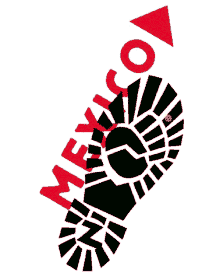 In February 2001, members of the EZLN began a march to Mexico City. The caravan included some of the oldest Zapatistas in the country who fought alongside of Emiliano Zapata at the beginning of the 20th century. Along the way they participated in the Third National Indigenous Congress with representatives of 40 of the 56 ethnic groups that live in Mexico. By the time the caravan reached Mexico City, it had grown to include several thousands of participants. [more]
In February 2001, members of the EZLN began a march to Mexico City. The caravan included some of the oldest Zapatistas in the country who fought alongside of Emiliano Zapata at the beginning of the 20th century. Along the way they participated in the Third National Indigenous Congress with representatives of 40 of the 56 ethnic groups that live in Mexico. By the time the caravan reached Mexico City, it had grown to include several thousands of participants. [more]
While representatives of the EZLN addressed the Mexican Congress, in the streets, two groups of Mexican designers, Fuera de Registro and La Corriente Electrica postered the city in solidarity.
The posters were also distributed by email with the following statement:
“The EZLN has arrived to Mexico City.
To welcome them, to support the indigenous people claims, to demand peace with justice and dignity, we have produced these images. Help us to distribute them. Use, share, print the images. We need every one’s help to demand the Mexican Government the following conditions to re-initiate the peace negotiatons with the EZLN.
- Constitutional recognition of the San Andres Agreements about Indigenous Rights and Culture.
- Freedom to all the zapatista prisoners.
- Withdrawal of the Mexican Army of the Chiapas Heights.
Mexico DF, March 2001.
Fuera de Registro, La Corriente Electrica.”
Rene Wanner has posted some images of the posters on his page, Zapata vive ! Mexican posters for peace in Chiapas.
“Fuera de Registro” is a pun which means “off register” in printing, as well as a person who can not vote because they are not registered.
Chiapas Indymedia has produced an audio documentary on ten years of Zapatismo.
Bombing Iraq
From Reuters, November 13, 2003:
“As political parties and businesses take advantage of a power vacuum in a country with as yet no elected government, constitution or parliament, Baghdad has become a city of graffiti.
Walls around the city of five million have been smothered with competing slogans since three decades of stifling state control and dictatorship ended in April with the ousting of Iraq’s president Saddam Hussein.”
From Al-Ahram Weekly via the Utne Reader:
“[Graffiti] has quickly become an important mode for Iraqis to freely express opinions of every nature. Nermeen Al-Mufti, reporting from Baghdad, writes that during the last two months the walls near her house have ‘been witness to the sentiments and longing of the Iraqi people.’ Before the fall of Baghdad to U.S. forces, the walls were entirely blank except for the face of Saddam Hussein. Now buildings throughout the city are covered with political and personal commentary from hugely differing perspectives.
Much of the writing is political in nature. After American troops entered Iraq many of the pictures of Saddam were defaced. A poster near Al Mufti’s house that had previously read ‘yes, yes to Saddam,’ was changed to ‘no, no to Saddam.’ Later someone added the word ‘criminal’ in front of Saddam’s name. However, anger and resentment is not, by any means, limited to the former leader of Iraq. One wall reads, ‘Americans, sooner or later we will kick you out.’ And at times the two opinions clash, ‘Thank you Mr. Bush,’ was later crossed out by someone else.
Ali Omer, a young writer in Baghdad, commented, ‘I discovered the draw-back of democracy, it dirties the walls!’ Metaphorically, the ‘dirty’ masses of opinions covering the walls reflects the greatly commingled ethnic and religious groups in the country. Shatha Hassan, a teacher in the Institute of Fine Arts, says that the walls reflect the massive instability of the country. Thus, some of the writing directed towards the future possibilities of an Iraqi government. Walls read, ‘Yes to a secular government,’ or, ‘There is no democratic Iraq without resolution of the Kurdish issue.’ On this note, there is also the positive outlook, ‘Arab and Kurds together will rebuild Iraq.’ Sadly, the walls are also representative of a war-torn country where positive steps forward are taken very slowly. One university student writing on the wall said, ‘We still don’t know if we’ll be taking our exams or not. Nobody reads the papers, so maybe our demands will be seen on the walls.’”
For a few more translations see Newsday.
Branding Peace
![]() A publisher of graphic design books in Barcelona will soon produce a book compiling a selection posters against the war in Iraq designed by artists around the world. When soliciting submissions, the editor announced that profits from the book would be donated to Amnesty International.
A publisher of graphic design books in Barcelona will soon produce a book compiling a selection posters against the war in Iraq designed by artists around the world. When soliciting submissions, the editor announced that profits from the book would be donated to Amnesty International.
I informed the editor that it was a little strange for a book of anti-war posters to support an organization that never actually opposed the war. He was shocked to hear this.
He quoted from Amnesty’s Web site:
“In February 2003, before the start of the war, Amnesty International handed to the UN a petition signed by more than 60,000 people in nearly 200 countries and territories calling on the Security Council to assess the human rights and humanitarian impact on the civilian population of any military action against Iraq.”
This is true, but this is not the same as opposing the war. In fact, this actually implies that the invasion is just fine as long as the humanitarian and human rights impact is within some acceptable limit. This is consistent with International Humanitarian Law. Under IHL, a certain amount of “collateral damage” is assumed. You can kill plenty of civilians, as long as you are not specifically targeting them and have taken some measures to minimize harm.
Amnesty does wonderful work on behalf of prisoners around the world, but they are not an anti-war organization. They are not actually opposed to war, but war crimes. Contradictions abound: Amnesty opposes the use of land-mines as “inhumane,” but takes no position on nuclear weapons. Amnesty also recently launched a campaign to control the trafficking of small arms, though they say nothing about the general trade of large weapons.
The editor wrote, “I went through a list of charity organizations and Amnesty is one that gets one of the highest marks for how much money they use from donations for actual causes rather than promotion etc. Also, they were only one of many charities who responded to my query.”
I pointed out that Amnesty’s is not structured like other organizations. Amnesty’s London office does all the research and generates materials for advocacy, but does no fundraising or marketing at all. It is Amnesty’s autonomous national offices that do the fundraising and marketing. The national offices send a portion of their funds back to the international headquarters in London. Thus, if you looked at the international headquarters of Amnesty it would appear that they spent all of their money on program work and none on fundraising. This is true, but misleading.
I also noted that Amnesty is a well-funded organization. The budget of the its international headquarters was £23,728,000 in fiscal year 2002. That headquarters employs 410 staff. In contrast, many of the small organizations and coalitions that came together specifically to oppose the war are struggling to stay afloat and to keep the pressure on. These groups could use the money a lot more than Amnesty.
The editor considered my arguments and later circulated a poll to let the contributing artists decide who should receive the proceeds. He wrote:
“My original plan for the book was to donate a portion of the profits from the book to a non governmental organization (NGO) which could use the money to help promote peace, non-violence, and help people affected by war. There are many such organizations around the world and it has been very hard to choose one to be the recipient of this donation. I am hoping that you, the artists, can help me choose one of these NGOs and make this a truly democratic project.
The following is a list of NGOs which are internationally recognized and are currently making efforts to help the people in Iraq, either by organizing people against the occupation, or helping people on the ground.
- Amnesty International
- International Answer
- International Committee of the Red Cross
- Not in Our Name
- Oxfam
- Peace Action
- Stop the War Coalition
- United for Peace & Justice
- Win Without War
- War Resisters League
Of the organizations listed, Amnesty International is the only one that has neither opposed to the occupation nor delivered supplies and relief to the people of Iraq. Instead Amnesty asks the occupying forces themselves to ensure that provisions and medical supplies are delivered. Take a look at Amnesty’s own briefing paper on Iraq. Amnesty calls for oil revenue to benefit the people of Iraq, but does not name specific U.S. contracts and companies profiting instead. Amnesty calls for “justice and security,” but not for the transfer of power to the people of Iraq. Amnesty calls for investigations into cases of abuse by US and UK soldiers in Iraq, but would never call for Bush or his administration to be held accountable for the lies that put them there.
No matter. When the votes were tallied, Amnesty International won by landslide.
Peace People Japan
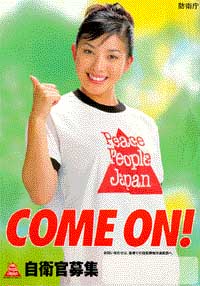 Wouldn’t it be great if we never had any need for a military? Failing that, how about a military forever sworn off of war? Japan’s military has done this for the last 50 years. This will soon change, however, as they enter the war in Iraq.
Wouldn’t it be great if we never had any need for a military? Failing that, how about a military forever sworn off of war? Japan’s military has done this for the last 50 years. This will soon change, however, as they enter the war in Iraq.
Article 9 of the constitution of Japan states:
“The Japanese people forever renounce war as a sovereign right of the nation and the threat or use of force as a means of settling international disputes.”
This is interpreted as permitting a standing army known as the Self-Defense Forces (SDF), but has prohibited those forces from being deployed outside of Japan or possessing nuclear weapons.
Still, with nearly 240,000 military personnel and an annual budget of nearly $50 billion in 2002, Japan’s military outstrips Britain’s in total spending and manpower. [source]
In the past Article 9 prevented the SDF from participating in military conflict and limited Japanese involvement to mostly financial support.
However, just as the United States wrote that constitution, Japan is slowly amending it under U.S. pressure.
“With each global ‘crisis,’ the Japanese government has taken the opportunity to enact new legislation to circumvent Article 9 and its clear renunciation of war.
One of the larger circumventions was the Peace Keeping Operations Law of 1992 which was passed during the Gulf War. This law allowed Japan to take part, if in a limited way, in United Nations-led peacekeeping operations. Other laws that have eroded the force of the Peace Provision are the 1999 law on Japan-U.S. security cooperation in dealing with emergencies around Japan, and the 2001 anti-terrorism special measures law.
The terrorist acts of September 2001 and the subsequent pressure from the United States has provided the latest opportunity for the Japanese government to pass legislation increasing the country’s legal right to conduct war.” [source]
Following the lead of the United States, the meaning of “self-defense” has now been expanded to include “pre-emptive” attack. In February 2003, Defense Minister Shigeru Ishiba warned that Japanese military would launch a pre-emptive military action against North Korea if it had firm evidence Pyongyang was planning a missile attack. It would be “a self-defense measure.”
In July 2003, the Diet approved a plan to send 1,000 troops to Iraq. The vote turned into an outright brawl on the floor between MP’s for and against the vote. (See the pic.)
This is not the first time Japan has cleaned up after a U.S. war. Japan gave $13 billion during the first Gulf War in 1991, but did not send troops. More recently, Japan deployed an SDF demining team to Afghanistan.
 Yesterday’s New York Times reports that deployment for Iraq is scheduled for early next year.
Yesterday’s New York Times reports that deployment for Iraq is scheduled for early next year.
That July article notes that the Japanese troops will help “resettling refugees, rebuilding and providing fresh water supplies that.” The Times, also states that the Japanese will “engage in unwarlike activities,” though ominously matches the article with photos of Japanese soldiers in camouflage make-up, members of an “antitank unit” during exercises in Japan.
The Times article also notes:
“Not one Japanese soldier has been killed, or has killed, in combat since the end of World War II.
That remarkable fact is being repeated here often these days, precisely because, as Japan prepares to send ground forces to Iraq, things could change in the near future. The death of a soldier, a sad though common reality for most nations, would be a pivotal point in Japan’s postwar history.”
 The “harmlessness” of military service, a deception implied by U.S. recruiting material, is actually thus far depicted honestly in SDF materials. Here are some links to some images of SDF posters. While U.S. recruiting posters sell adventure spiced with danger and travel, the pitch here displays neither — instead mixing the adventure with uniforms, aviation, and naval technology.
The “harmlessness” of military service, a deception implied by U.S. recruiting material, is actually thus far depicted honestly in SDF materials. Here are some links to some images of SDF posters. While U.S. recruiting posters sell adventure spiced with danger and travel, the pitch here displays neither — instead mixing the adventure with uniforms, aviation, and naval technology.
The posters also seem to sell the SDF as something like a sports club, a way to impress your country, kids, and co-eds, and, recently, a distinguished career option for women. And then there’s that bizarre sci-fi poster. But then I can’t read Japanese so could be totally misinterpreting the signs.
As the Japanese military is a “Self-Defense Force,” their logo brands them as keepers of peace. The SDF are “Peace People Japan.”
The posters have been removed from the SDF site so the links above point to the Web Archive.
However, this small collection of cuddly cartoon characters is still online.
Ill Communication
In the same sitting, I stumbled into two articles on the use of cellphones to coordinate street protest in real time. One in La Paz, the other in London, the former well organized, the latter ad-hoc. One from the country, the other from the city.
From Anarchogeek:
“The use of cell phones is interesting in how it relates to transforming the rural/urban power divide within the developing world. This isn’t something entirely new, rural community radio stations have played very large roll in communication and social transformation. In Bolivia, the revolution of 1952 lead by the miners unions, was coordinated by a network of rural community radio stations. With high illiteracy, little infrastructure, very poor communities these communities have relied on radio as the primary form of mass media.
In the last decade there has been an upsurge in the political power of indigenous movements in the Andes who have their power base in rural mostly disconnected communities. A lot of that upsurge is due to the many years of organizing by indigenous leaders, social movements, and NGO’s. That said, cell phones have acted as a major amplifier of their work. Increasing the ability for people to coordinate their actions and build robust social networks.
Unfortunately, I’ve not seen much written about the use of cell phones and other communications technology in the general strike and ‘Gas War’ in Bolivia last month. From my working with the rather small group of indymedia people in Bolivia I’ve heard some of how cell phones transformed the conflict. It helped people lay a more than week-long siege to La Paz. It also helped coordinate the marches of people from other parts of the country to the capital. When women went on hunger strike in churches the communications network made it a coordinated act, not simply the act of a few brave women in one location.
I think what happened in Bolivia is quite different than the much talked about ‘smart mobs’ as there were relatively few people will cell phones. The groups were not flexible, but rather quite well organized with cell phones used to coordinate between the leadership of existing organizations and networks. The use of cell phones facilitated the biggest indigenous siege of La Paz in almost 300 years.
Other important factors was Pios Doce and other community radio stations which played a vital mass media roll during the crisis. The Pios Doce transmitter in Oruro was bombed, by people who clearly didn’t expect the police to investigate anything. What the government didn’t figure out how to do was shut off the cell phones of known organizers, or towers which serve indigenous communities. My guess is the reason they didn’t shut them down was in part because cell phones were a vital communications tool for the police and army. Even the US Army in Iraq makes extensive use of consumer walkie talkies and unencrypted Instant Messenger. In India texting has been shut off at critical points to stem the spread of rumors and coordinated race riots during communalist uprisings in the last year. I expect as social movements turn to using cell phones and related technology as a tactical tool during protests and uprisings the governments will eventually learn how to turn off the ability to communicate at will.”
This last point is also noted in the BBC article about protestors chasing Bush in London:
“Some newspapers and websites were reporting mobile phone signals could be blocked for fear they could remote-control a bomb. But Scotland Yard has denied reports that police were considering shutting mobile phone masts during protests.”
In contrast to the Bolivia protest which shut down the capitol, the UK protests are intended to be a media hack and an adjunct to the big, organized, legally-sanctioned anti-war march on Thursday.
 “The Chasing Bush campaign is asking people to ‘disrupt the PR’ of the visit by spoiling stage-managed photos.
“The Chasing Bush campaign is asking people to ‘disrupt the PR’ of the visit by spoiling stage-managed photos.
They are being encouraged to send location reports and images by mobile to be posted on the Chasing Bush site....
Technologies like text messaging and weblogs have been successfully used in the past to co-ordinate routes and meet-up points for mass protests.
But the gadgets are now being used more proactively to make protests more visible and disrupt any potential stage-managing of the President’s visit.
‘We are trying to spoil the PR, so we are not doing anything directly, but encouraging people to protest by turning their backs in press photos so they can’t be used.’
The campaign organisers have also asked people to go into protest ‘exclusion zones’ to send SMS updates and on-location reports about his appearances, and events at protests.”
See this previous post for more notes on electornic advocacy.
Mapping the State of the World
Myriad Editions specializes in one type of book: thematic atlases on economic, political, and social trends. The State of the World thematic atlases are full of maps, tables, cartograms, and other infographics that make global issues accessible at a glance.
The first State of The World Atlas was published in 1981 by Pluto Press. It was co-edited by Ronald Segal and Michael Kidron, until his death in March 2003. The book can be seen as part of his attempt to understand and write about capitalism on a global scale. The War Atlas followed in 1983.
Myriad’s list of titles includes:
- The State of the World Atlas (now in its 7th edition)
- The Atlas of War and Peace
- Atlas of Women in the World
- The State of Religion Atlas
- The State of the Environment Atlas
- The Atlas of Endangered Species
- The Atlas of Food
- The State of Health Atlas
- The Atlas of Human Sexual Behavior
- The Tobacco Atlas
- The Penguin Atlas of Media and Information
- and The Atlas of the Future
Individual countries atlases have been published on China, the USA, Germany, and France.
Coming soon: The Water Atlas and Atlas of the Middle East.
See some sample maps and their project for UNICEF illustrating the state of the world’s children.
They’ve done a couple of interactive, online maps for other organizations, too.



